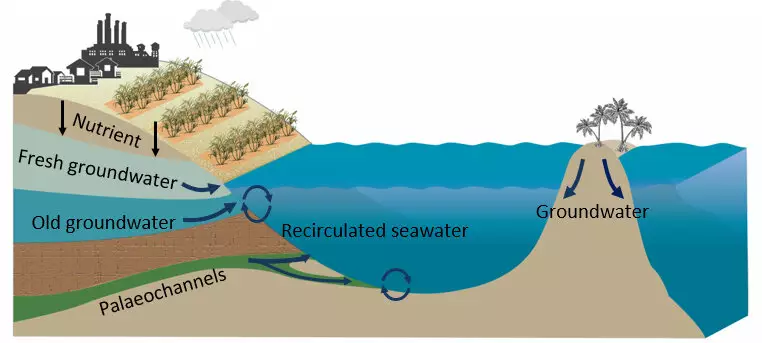The Great Barrier Reef, located off the coast of Queensland, Australia, is facing immense environmental challenges that threaten its health and biodiversity. Scientists have recently made a groundbreaking discovery regarding the source of previously unquantified nitrogen and phosphorous that are negatively impacting the reef. This new information suggests that existing conservation and restoration efforts may need to be reevaluated to effectively protect this iconic ecosystem.
Researchers, led by Dr. Douglas Tait from Southern Cross University, conducted a study titled “Submarine groundwater discharge exceeds river inputs as a source of nutrients to the Great Barrier Reef,” published in Environmental Science & Technology. This study utilized natural tracers to identify the origin of nitrogen and phosphorous influxes to the reef. The team collected data from offshore transects, rivers, and coastal bores spanning a vast area from south of Rockhampton to north of Cairns.
Submarine groundwater discharge refers to the release of water into the ocean below the waterline from various sources, such as underground aquifers and the seafloor. Through the use of radium isotopes, the scientists were able to quantify the nutrient flow from land and shelf sediments via invisible groundwater flows. Surprisingly, the findings revealed that submarine groundwater discharge contributed 10-15 times more nutrients to the reef than river inputs, a factor that had previously been overlooked.
Implications for Conservation Efforts
The prevailing focus of efforts aimed at mitigating nutrient impacts on the Great Barrier Reef has been on reducing outflow from river systems. However, this study highlights the need for a strategic shift in management approaches. Lead author Dr. Douglas Tait emphasizes that while nutrients are essential for the reef’s biodiversity, excessive nutrient loads can result in harmful consequences such as algal blooms, crown-of-thorns starfish outbreaks, and fish diseases, which have been steadily increasing in the reef over the past few decades.
One significant difference between river outflow and groundwater discharge is the timeframe in which nutrients are released into the coastal waters. Unlike rivers, nutrients stored in groundwater can remain underground for decades before being discharged. This aspect underscores the importance of long-term research and strategies to protect the Great Barrier Reef from the detrimental effects of excess nutrients.
A Call for a Paradigm Shift
To safeguard the reef’s health, there is a pressing need for a strategic realignment of management approaches. Traditional reliance on river management must be complemented by greater attention to the influence of submarine groundwater discharge. Dr. Tait explains that this study provides new insights into the intricate nutrient dynamics within the Great Barrier Reef, which will aid in the development of more effective conservation strategies.
The discovery of previously unidentified sources of nitrogen and phosphorous impacting the Great Barrier Reef through submarine groundwater discharge calls for a reevaluation of current management practices. This study highlights the need for long-term research and strategies to conserve the reef’s biodiversity effectively. By comprehensively understanding the nutrient dynamics within the Great Barrier Reef, scientists and conservationists can implement targeted measures to mitigate the detrimental impacts of excess nutrients and sustain the health of this remarkable natural wonder.



Leave a Reply